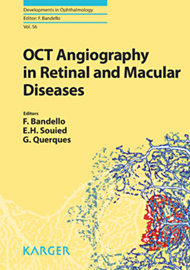OCT angiography (OCT-A) is based on the concept that in a static eye, the only moving structure in the fundus of the eye is blood flowing through the vessels. This book explains how the technique allows a depth-resolved analysis and clear visualisation of retinal and choroidal tissue.
Superficial capillary plexus (SCP) and deep capillary plexus (DCP) can be visualised in OCT-A and further insight into the choroidal flow can be obtained. The introductory chapters explore the technical intricacies of the main competitors in the arena such as Heidelberg’s Spectralis, Optovue, Swept-Source OCT Angio (Topcon) and Zeiss’s Angioplex.
The book then moves onto a discussion of diagnostic features seen in the OCT-A in specific pathologies involving the chorioretinal vascular network. Since age-related macular degeneration (AMD) continues to be the leading cause of blindness in the over 50s in the western world, the book dedicates extensive information to this area. In the context of wet AMD, the role of OCT-A in Type I choroidal neovascularisation (CNV) (occult), Type II (classic) and Type III (retinal-retinal anastomoses) is highlighted. Examples and case studies help the clinician to understand how to identify and measure the response of the pathologic vessels to therapy.
The book highlights the potential usefulness of OCT-A in monitoring the response of therapies in clinical trials for dry AMD. One learns that OCT-A may not be used as a standalone tool but rather a novel complement to fundus fluorescein angiography (FFA) in the diagnosis of myopic CNV. It is emphasised that OCT-A can provide information regarding the localisation and morphology of vascular lesions, due to its unique segmental modality of data acquisition and is non-inferior to FFA in detecting vascular alterations of the posterior pole in the diabetic retina. In retinal vascular occlusions OCT-A can be used to image the retinal capillary plexus at different levels, and this may allow detection of neovascularisation or anastomosis; however, the motion, blink artefacts, segmentation and distortion of retinal architecture in thinning and oedema are pitfalls that can lead to a miscalculated estimation of the degree of vascular perfusion.
OCT-A technology appears to be the first to provide evidence that paracentral acute middle maculopathy (PAMM) is the result of ischaemia of the deep capillary plexus. It is also ideal for imaging macular telangiectasia 2 (MacTel2) where the earliest changes in the retinal microvasculature involve the temporal aspect of deep capillary plexus. In chorioretinal dystrophies OCT-A reveals alterations located at the level of deep capillary plexus and choriocapillaris. It is highlighted that OCT-A offers promise in paediatric ophthalmology because of its non-invasiveness and short acquisition time.
Numerous good quality colour images complement the well laid out text. Most clinicians using OCT-A will benefit from sharing the author’s experience and research of this new methodology. This book is suitable for ophthalmologists, optometrists and technicians with a special interest in medical retina.





